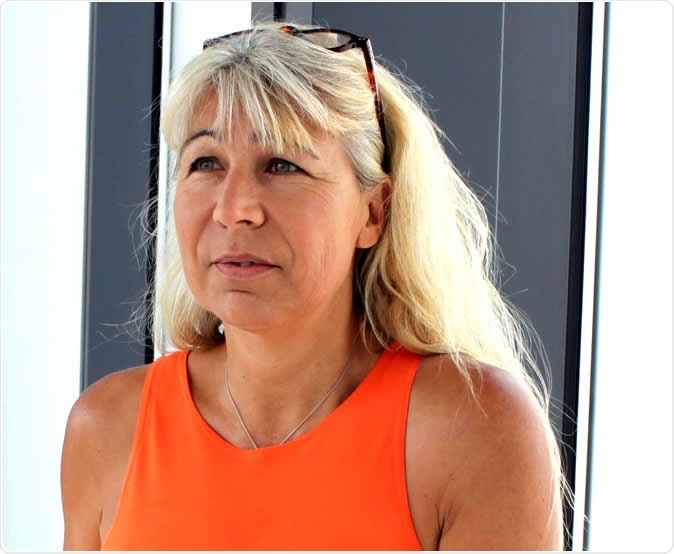Researchers have found that more intensive chemotherapy maintenance for ovarian cancer could be beneficial for patients. The results of the study were presented at the ESMO Congress 2019 in Barcelona, Spain last weekend on the 28th of September.
The study was titled, “Phase III PAOLA-1/ENGOT-ov25 trial: Olaparib plus bevacizumab (bev) as maintenance therapy in patients (prs) with newly diagnosed, advanced ovarian cancer (OC) treated with platinum-based chemotherapy (PCh) plus bev”.
The researchers showed that the treatment of ovarian cancer could be maintained by PARP inhibitor olaparib added to bevacizumab among all the patients irrespective of their BRCA mutation status. The trial called the PAOLA-1/ENGOT-ov25 trial results were presented by Professor Isabelle L. Ray-Coquard from Centre Leon Berard, Universite Claude Bernard, Lyon, and president of the GINECO group France.

Prof Isabelle Ray-Coquard, Centre Leon Bérard, Université Claude Bernard, Lyon, and president of the GINECO group France, abstract author. Image Credit: © European Society for Medical Oncology
Ovarian cancer standard therapy
The team explains that ovarian cancer remains the fifth most common cancer among women globally and is one of the most life-threatening gynaecological cancers which kills thousands each year. Most patients have a short lifespan after detection of the cancer mainly because the cancer is detected late in a more advanced stage. Many women respond well to first line chemotherapy and treatment, but the cancer is usually back in many women within two years of remission, the researchers explained. At present platinum-based chemotherapy following surgical removal of the cancer along with bevacizumab is the standard therapy. A maintenance therapy with bevacizumab alone is also a standard practice.
Trial design
In this phase III trial the team of researchers looked at the efficacy and safety of a PARP inhibitor with bevacizumab as maintenance therapy in women with ovarian cancer on remission with or without ovarian cancer mutation called the BRCA mutation. The PAOLA-1/ENGOT-ov25 is the first phase III trial was an international trial conducted on 806 patients with stage III/IV ovarian cancer who had shown partial or complete response to standard therapy with a platinum chemotherapy followed by bevacizumb. The participants were divided into two groups in a 2:1 manner. The larger group was on olaparib and bevacizumab while the smaller group was on placebo and bevacizumab. Olaparib was continued for up to 24 months (average 22.7 months for placebo arm) while bevacizumab was continued for 15 months. The researchers looked at the survival of the patients without progression of the disease. Ray-Coquard explained that in this trial the women were included in the study an average of six weeks after completion of their initial chemotherapy. She said, “It is an important point to consider when comparing the results to other data.”
Results
Results showed that for around 2 years of follow up with olaparib or placebo combination with bevacizumab, the median progression-free survival was 22.1 months in the olaparib group and 16.6 months in the placebo group (hazard ratio of 0.59). Professor Ray-Coquard in a statement said, “This study reports the greatest hazard ratio (0.59) and longest progression free survival we have ever seen.” She added, “Patient selection was not restricted by surgical outcome or BRCA mutation status, so participants represent the general population of women with advanced ovarian cancer. Previous studies of relapse have suggested benefits from combining anti-angiogenic agents and PARP inhibitors and today's results appear to support this. In addition, olaparib did not increase side-effects compared to placebo.”
Special findings
On further analysis it was seen that among women with BRCA mutation the survival benefit was even more with olaparib compared to placebo. Among women with homologous recombination deficiency (HRD) as well the results were markedly in favour of olaparib, the team wrote. Among patients with BRCA mutation, the median progression free survival with olaparib was 37.2 months. Ray-Coquard said, “The results in HRD patients without a BRCA mutation identify, for the first time, a patient population with greater clinical benefit from olaparib when added to bevacizumab.”
Where do we go from here?
Dr Ana Oaknin, Vall d´Hebron Institute of Oncology (VHIO), Barcelona, said in a statement, “The main goal in ovarian cancer is to avoid relapse after first-line therapy because otherwise the probability of cure is quite low. The combination of bevacizumab and olaparib as maintenance therapy should become a new standard of care for patients with advanced ovarian cancer. The PAOLA-1/ENGOT-ov25 trial did not include patients with no response to first-line chemotherapy, but this is a small group. This trial is a significant step forward in treatment for these women.” Oakin explained that there have been two other trials on advanced ovarian cancer with PARP inhibitors such as niraparib (in the PRIMA trial) and veliparib (in VELIA/GOG-3005 trial). According to her these three trials and others have included PARP inhibitors in the first line and maintenance therapy of advanced ovarian cancers. She said, “After decades studying different chemotherapy approaches, it is the first time we have meaningfully prolonged progression free survival and hopefully we will improve long-term outcome.” According to her, “The five-year overall survival for ovarian cancer is around 45% and we need strategies to improve that figure. I think the next approach is to incorporate immunotherapy as part of first-line therapy. Ongoing trials are expected to report in two to three years.”
The PAOLA-1/ENGOT-ov25 trial was funded by the ARCAGY Research, AstraZeneca and Roche.
Source:
Journal reference:
LBA2_PR ‘Phase III PAOLA-1/ENGOT-ov25 trial: Olaparib plus bevacizumab (bev) as maintenance therapy in patients (prs) with newly diagnosed, advanced ovarian cancer (OC) treated with platinum-based chemotherapy (PCh) plus bev‘ will be presented by Isabelle L. Ray-Coquard during the Presidential Symposium I on Saturday, 28 September, 16:30 to 18:20 (CEST) in the Barcelona Auditorium (Hall 2). Annals of Oncology, Volume 30, Supplement 5, October 2019